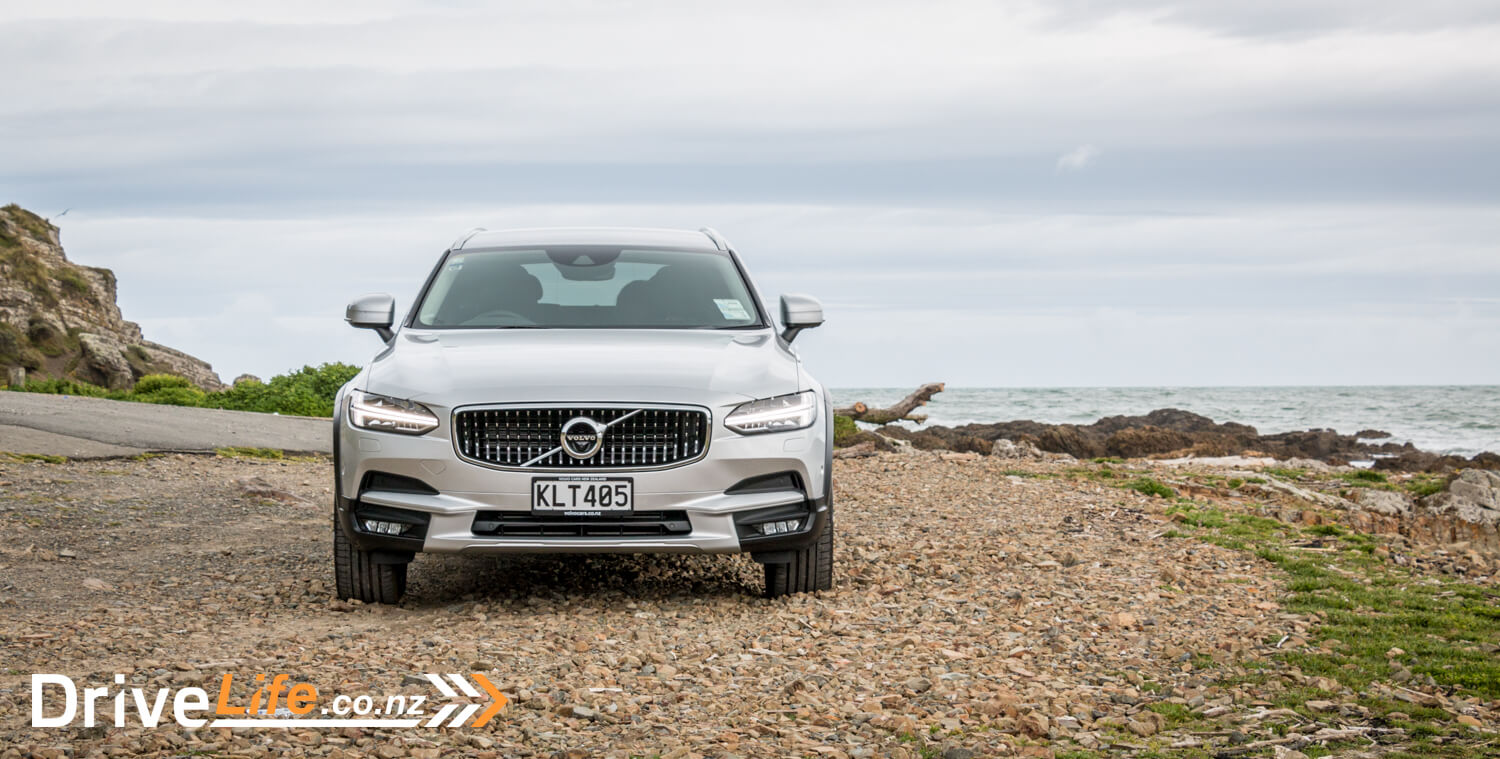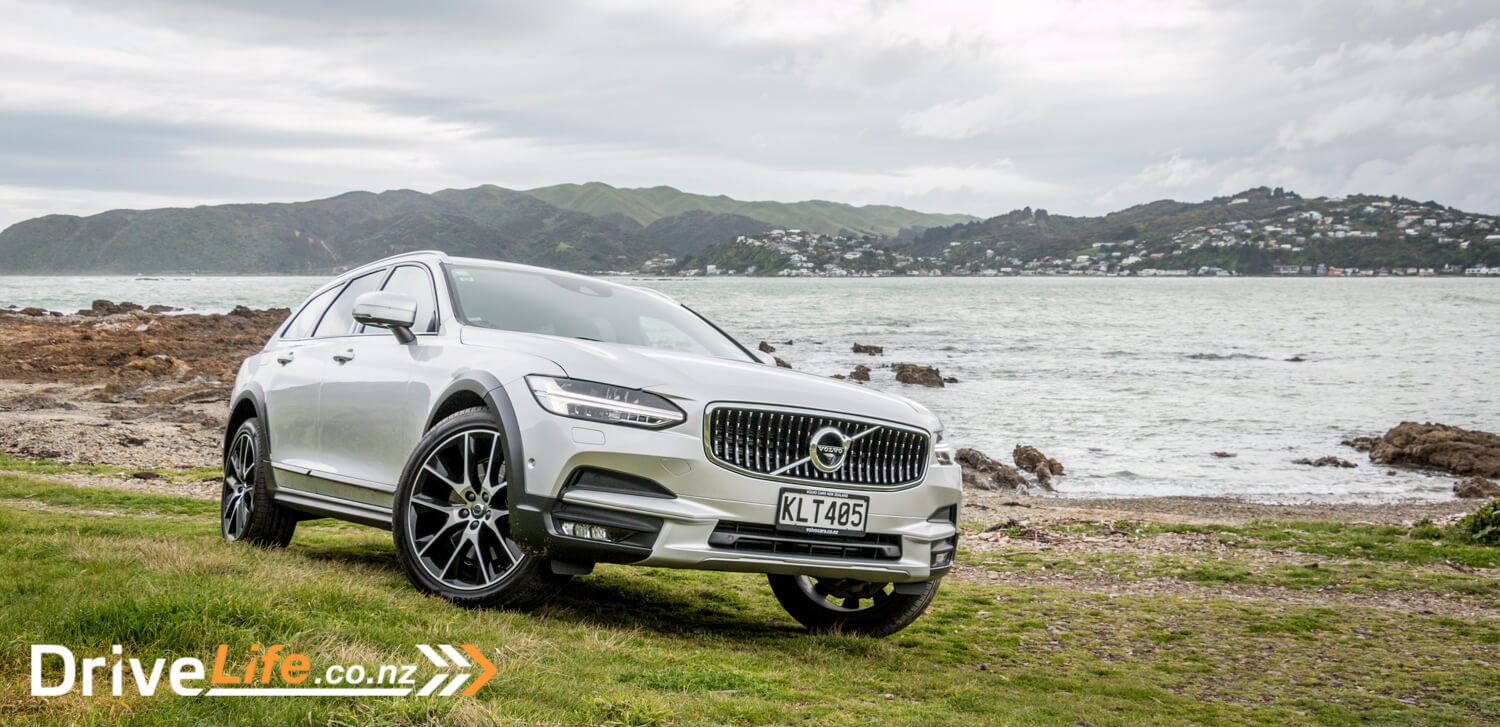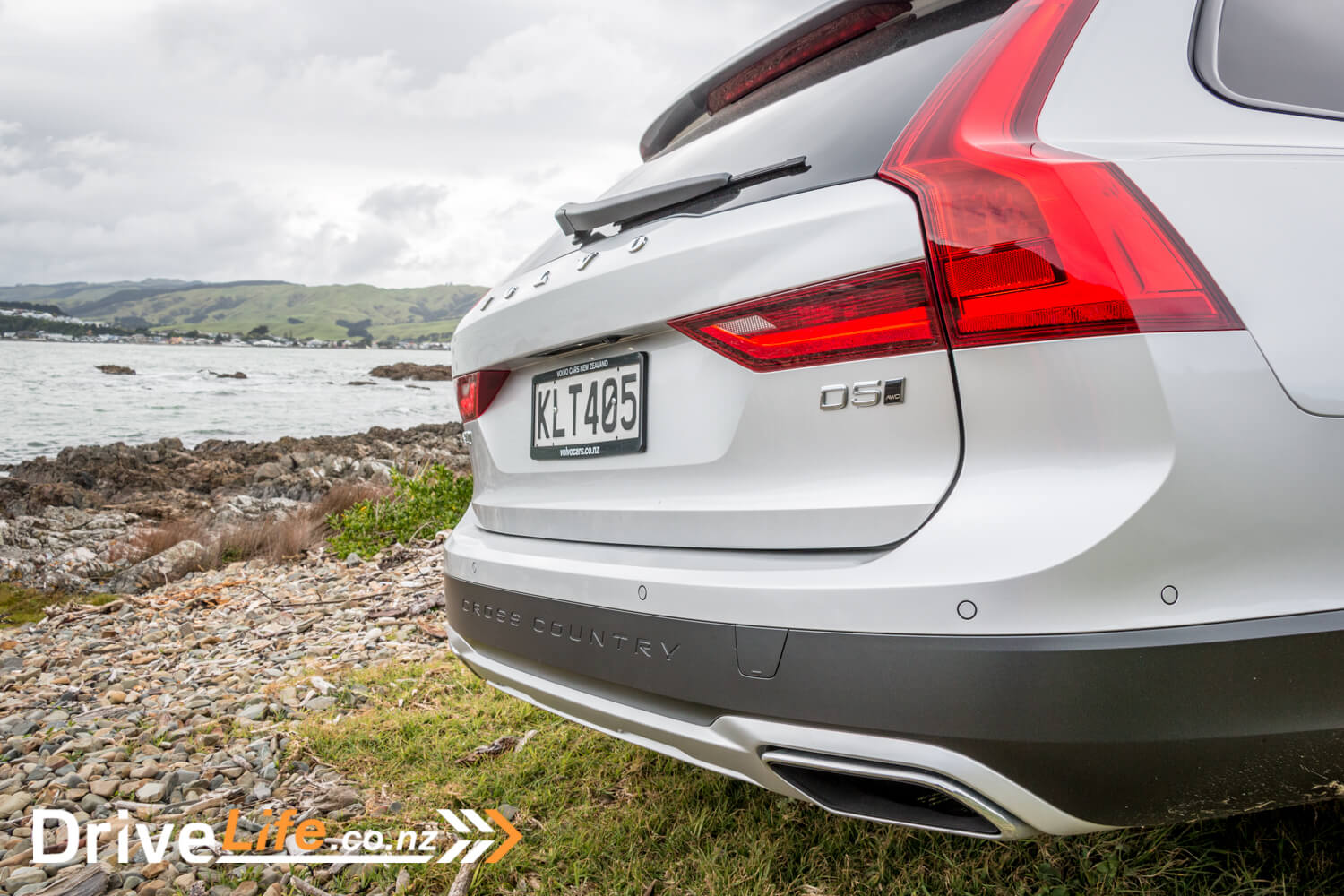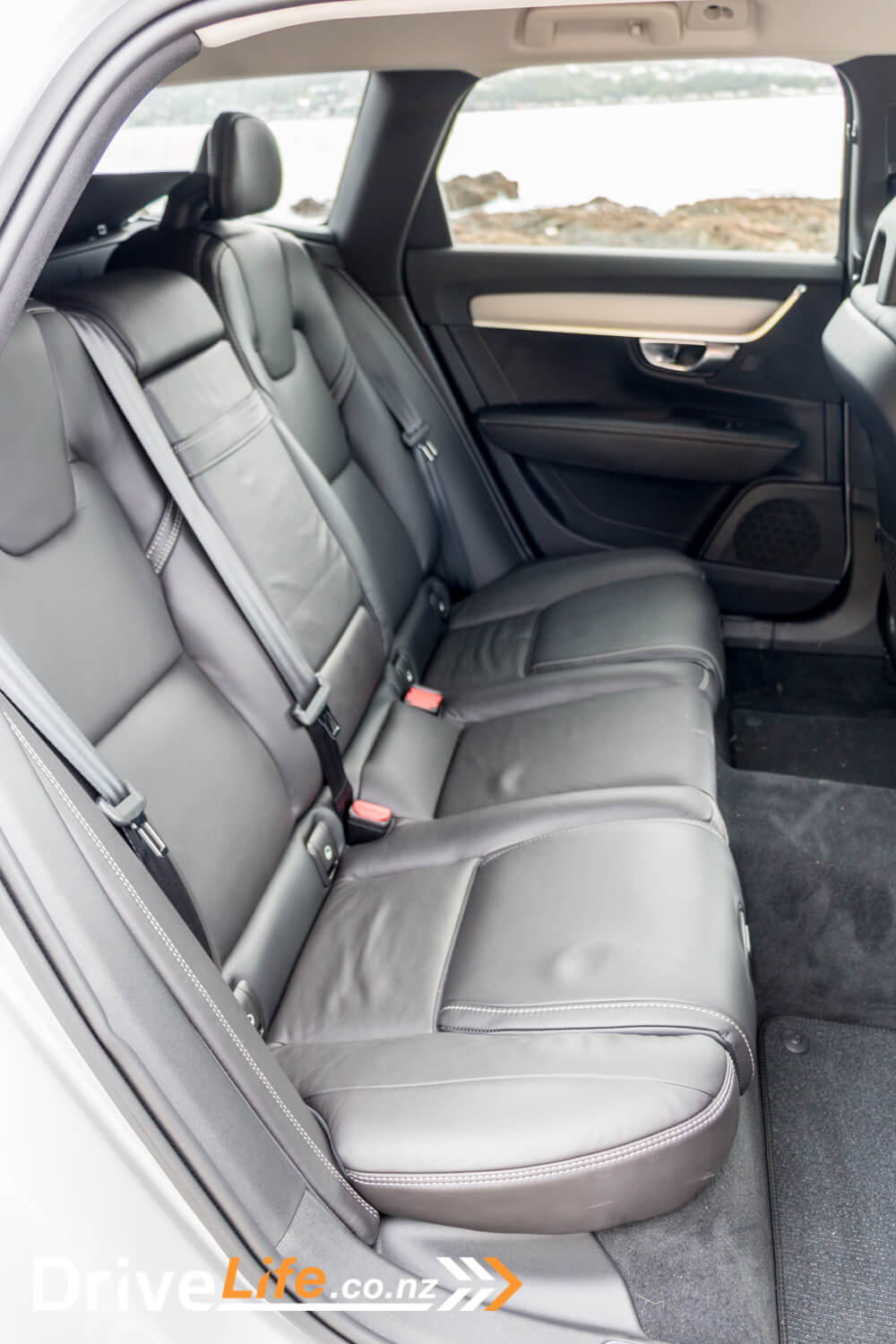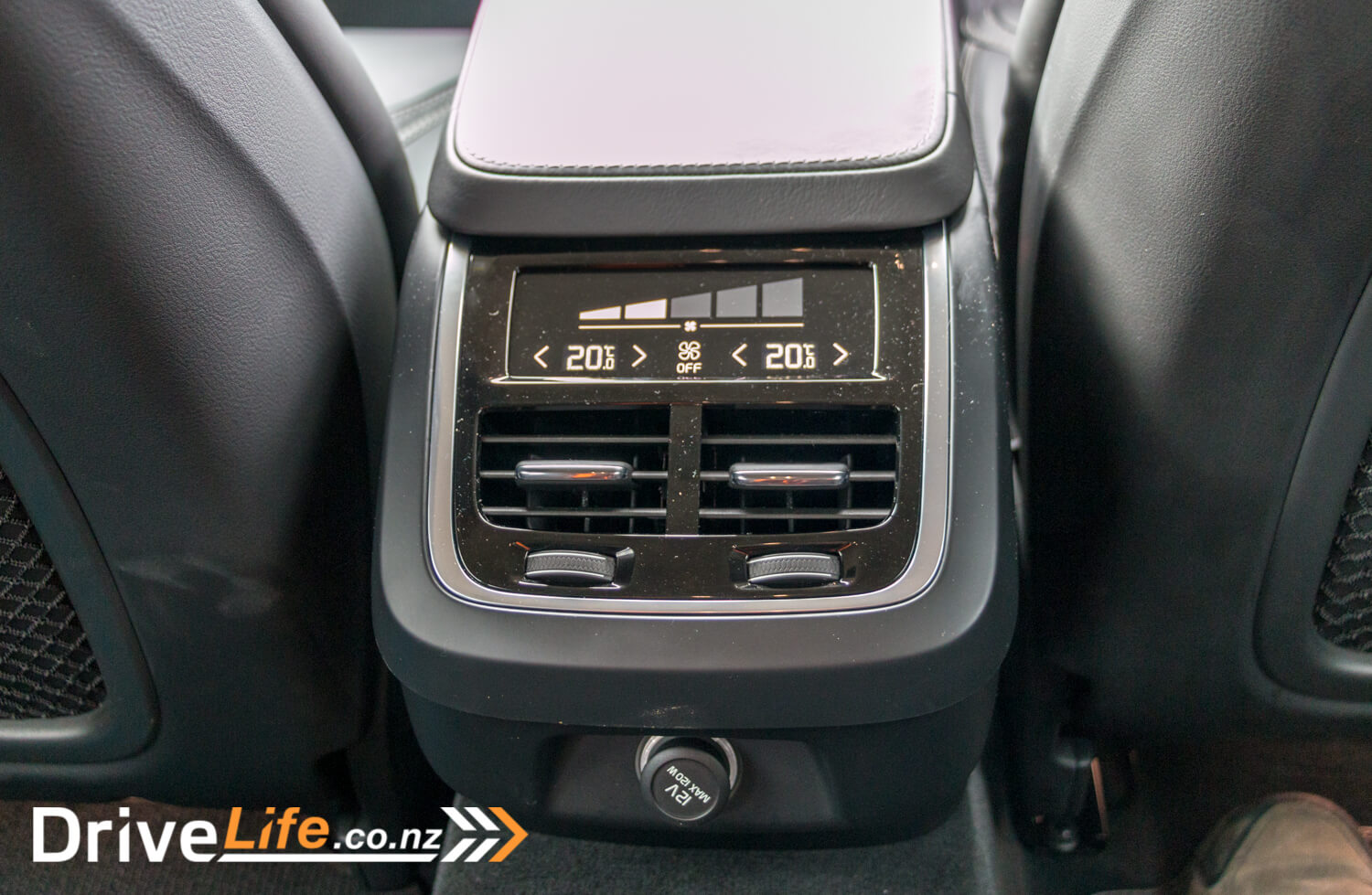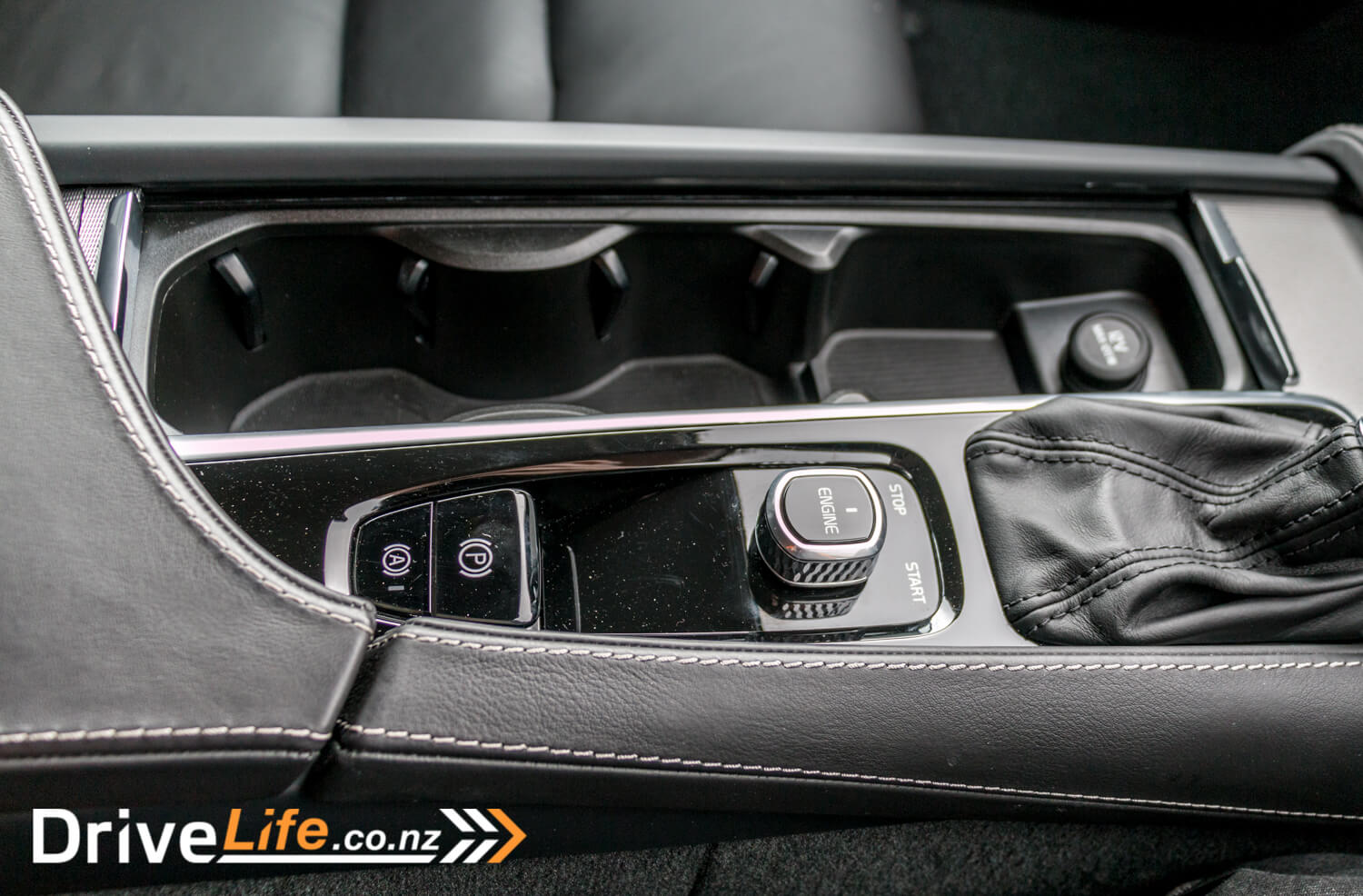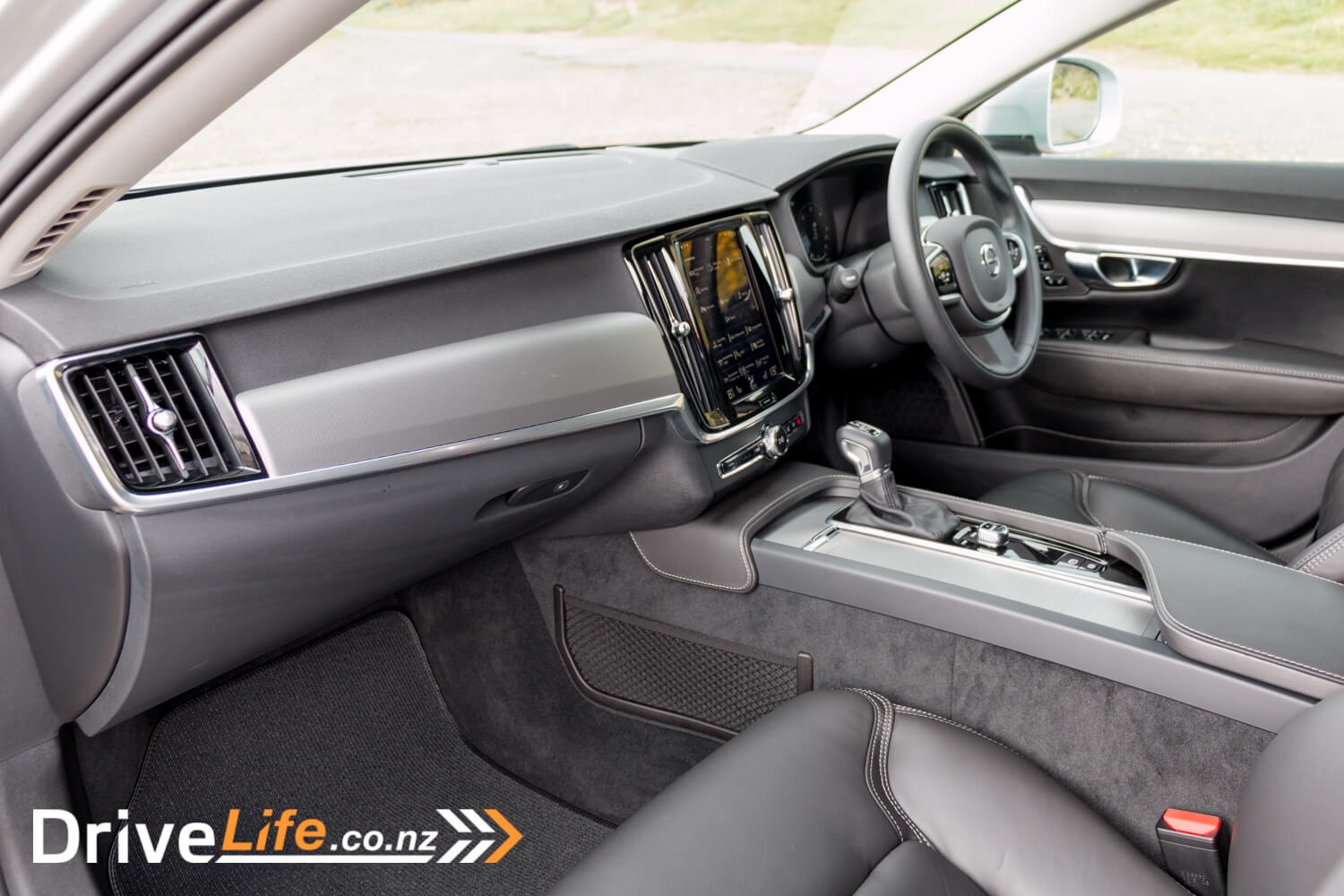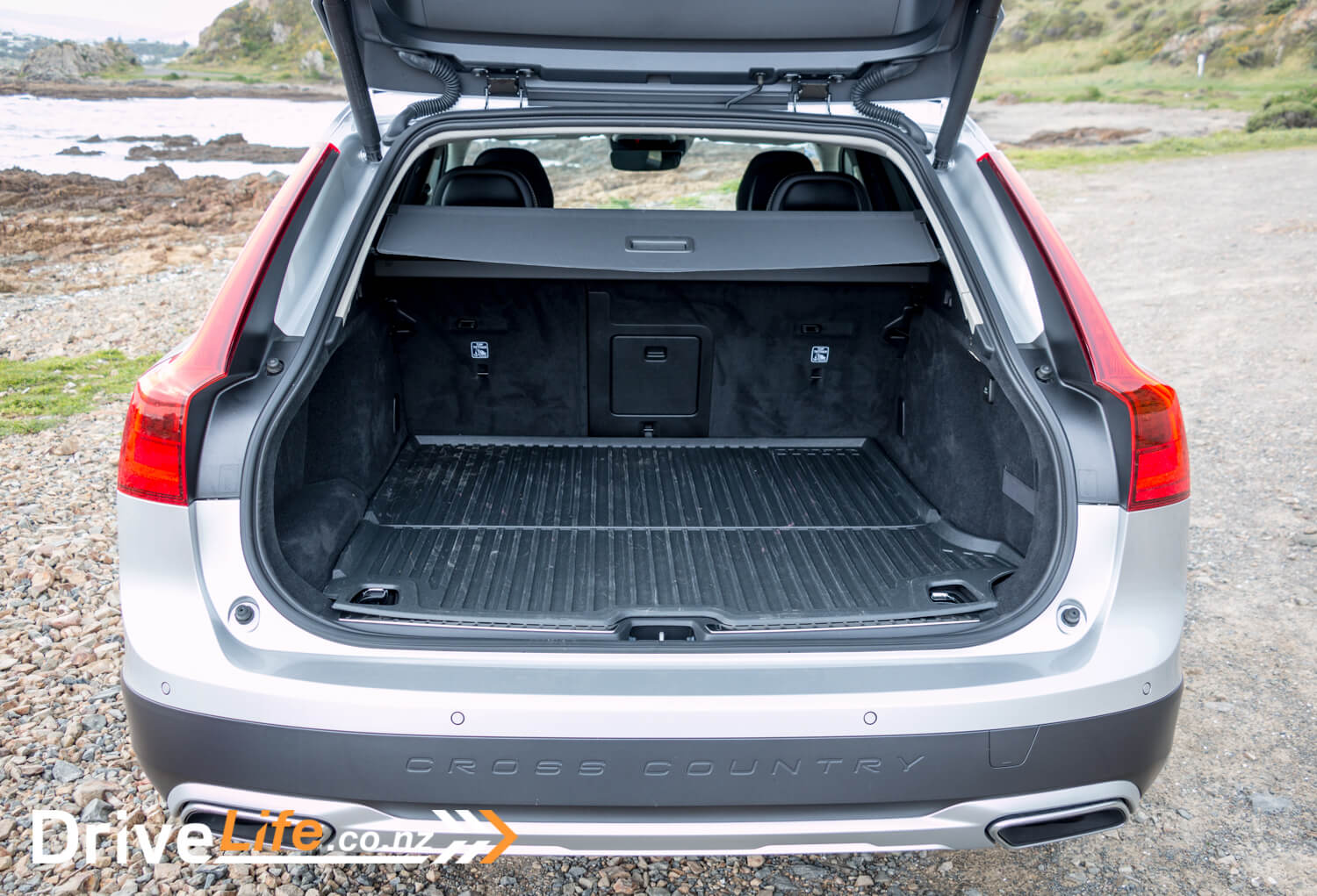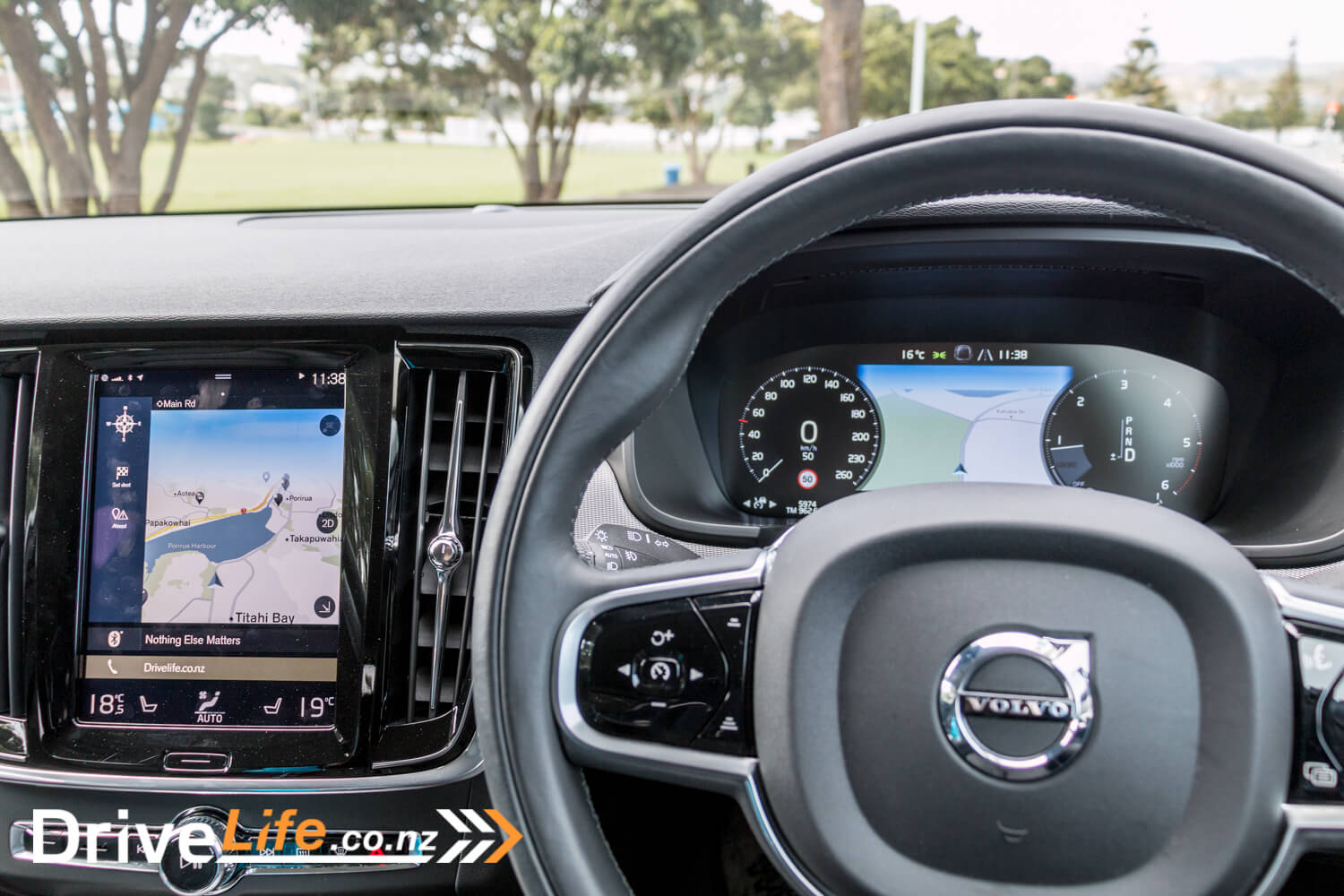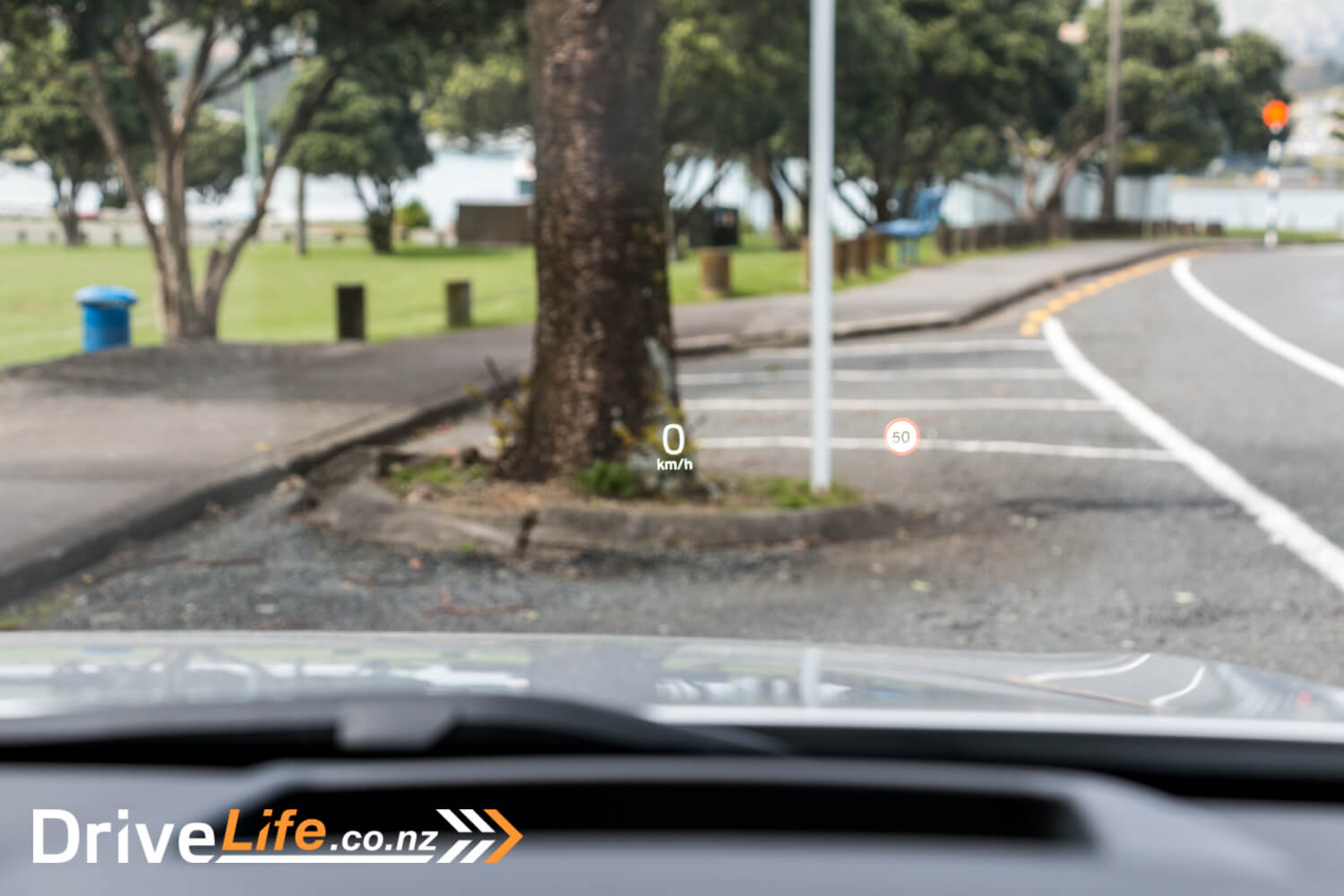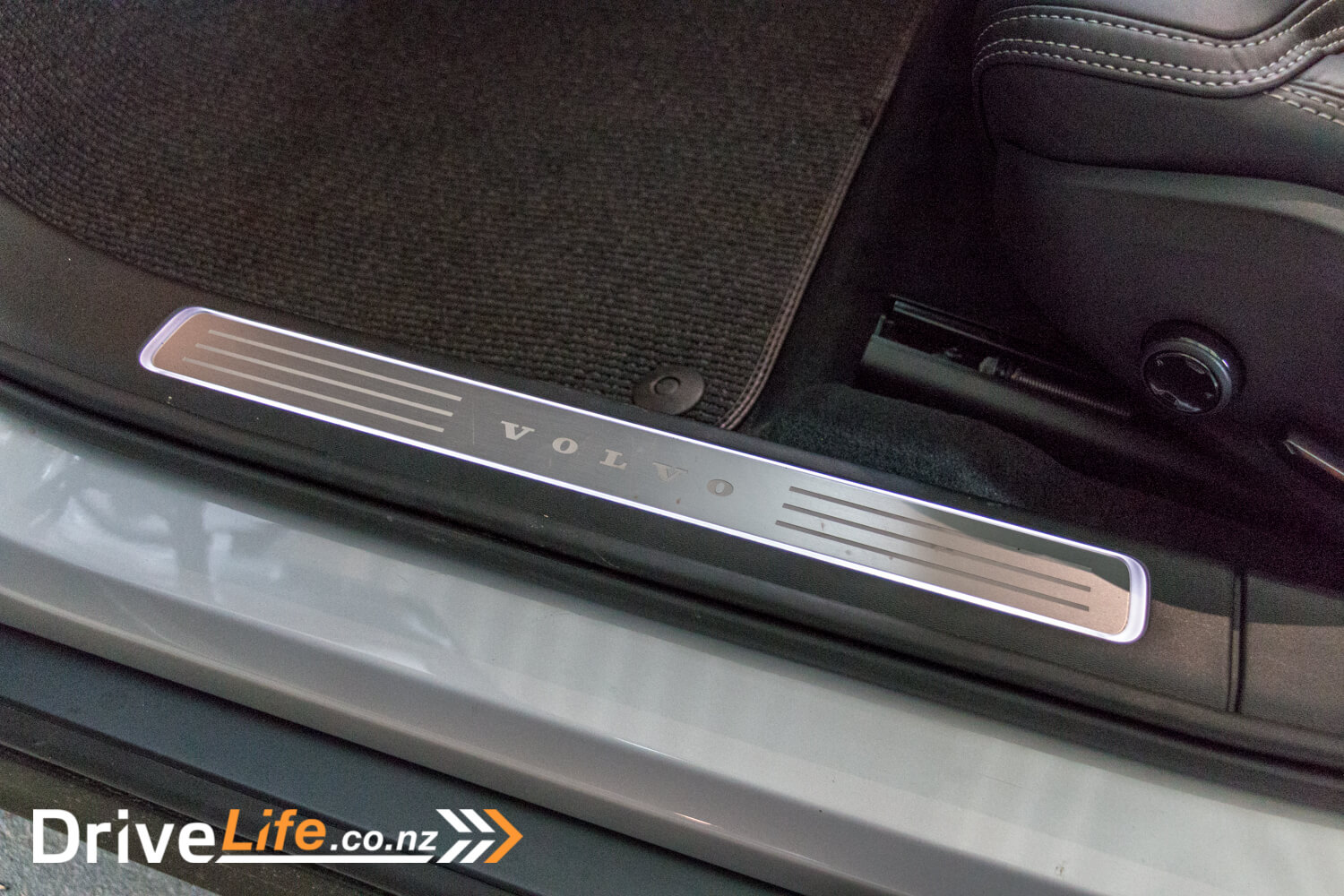Volvo have been experiencing something of a renaissance in recent years, since they were purchased by the Chinese Geely Holding Group. Given their recent improved reputation, we were looking forward to testing their large luxury wagon, the V90. The Cross Country version tested here takes the standard car and adds four-wheel drive, a raised ride height and chunkier exterior plastics to give you a light off-roading ability. It’s meant as more of an all-roader than an off-roader.
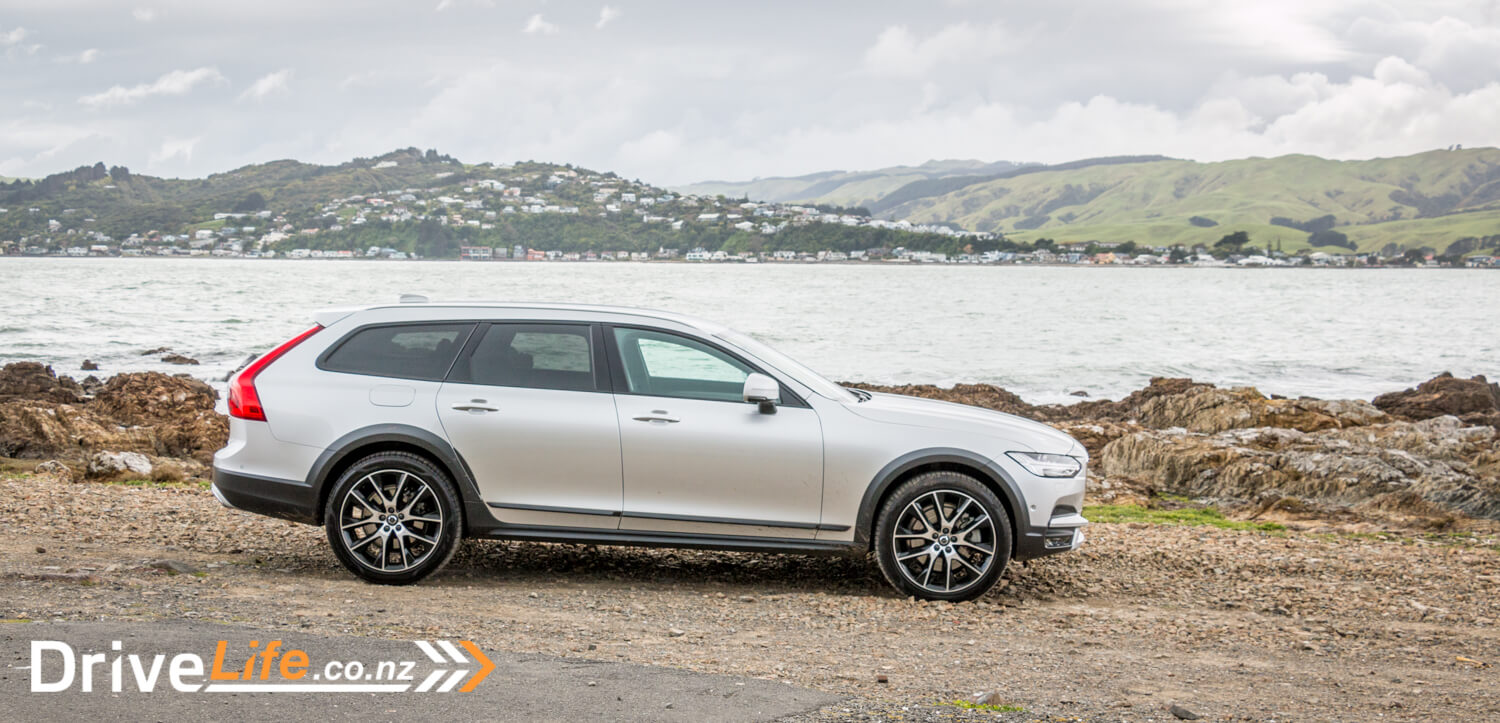
The Range
In New Zealand there’s one trim level of V90 available, priced at $103,900. And it has an impressive list of features. Power is supplied by Volvo’s D5 engine – an inline four-cylinder twin turbo diesel making 173kW and 480Nm. This drives all four wheels via an eight-speed automatic transmission. Exterior details include 20” wheels, front skid plate, LED headlights with Active Bending Lights and Active High Beam, power tailgate, power mirrors,
On the inside you have Clean Zone with Air Quality System, Nappa leather seats, four zone climate, keyless entry and start, power seats with memory on the driver’s side, child seat boosters, Apple Carplay and Android Auto, Satnav, and voice control.
As you might expect with Volvo’s reputation, the longest list on the spec sheet is safety and security, including 360 degree camera, adaptive cruise, Advanced Electronic Stability Control including Corner Traction Control with Torque Vectoring; Roll Stability Control; and Engine Drag
Control, Auto dimming mirrors including side mirrors, Blind Spot Information System with Steer Assist, City Safety – Front Collision Warning; Autonomous Emergency Braking; Pedestrian, Cyclist & Large Animal Detection with Night Functionality; Autobrake at Intersection, Cross Traffic Alert, Distance Alert, Driver Alert, Front, Side, Curtain & Knee Airbags, Hill Descent Control, Hill Start Assist, Park Assist Pilot – Parallel & Perpendicular Self-Parking with
Sensors Front & Rear, Pilot Assist – Semi-Autonomous Driving From Standstill to 130
km/h, auto lights and wipers, Run-Off Road Mitigation & Protection, Road Sign Information, Rear Collision Warning and Mitigation, Whiplash Injury Protection System – Front Seats. Quite the list!
There are 14 colours available but all are very muted variants on silver, blue or brown. That said, this is not the sort of car you’d want to spec in some crazy colour, it’s all about quiet style and subtlety. There are quite a few options you can add to that if you want, including panoramic sunroof ($2915), Bowers and Wilkins audio system ($4900), heated windscreen washers ($200), the list goes on!
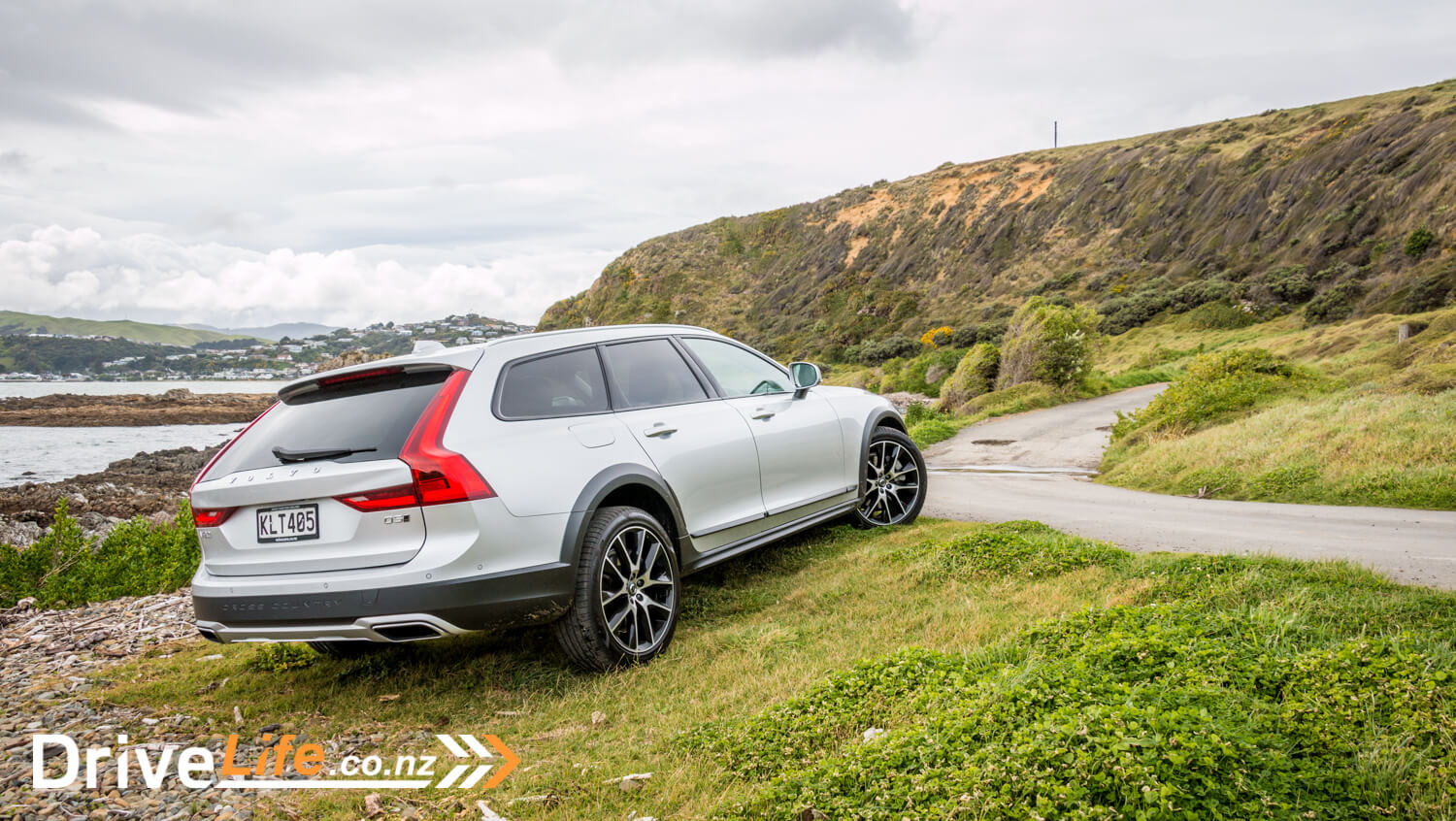
First Impressions
Our test car came in Bright Silver, and I know we usually go on about silver/grey cars here at Drive Life, but in this case it works beautifully. This car is a looker, with its big, concave Volvo-logoed grille, “Thor’s Hammer” running lights, long, sleek side profile and twin-exhausted rear, with those huge red tail light clusters. The Cross-Country chunky plastic isn’t over-done and helps give the car a rugged appearance. I really liked it. It has just the right amount of flashiness to look great without throwing it in your face. Volvo’s designers definitely nailed it here.
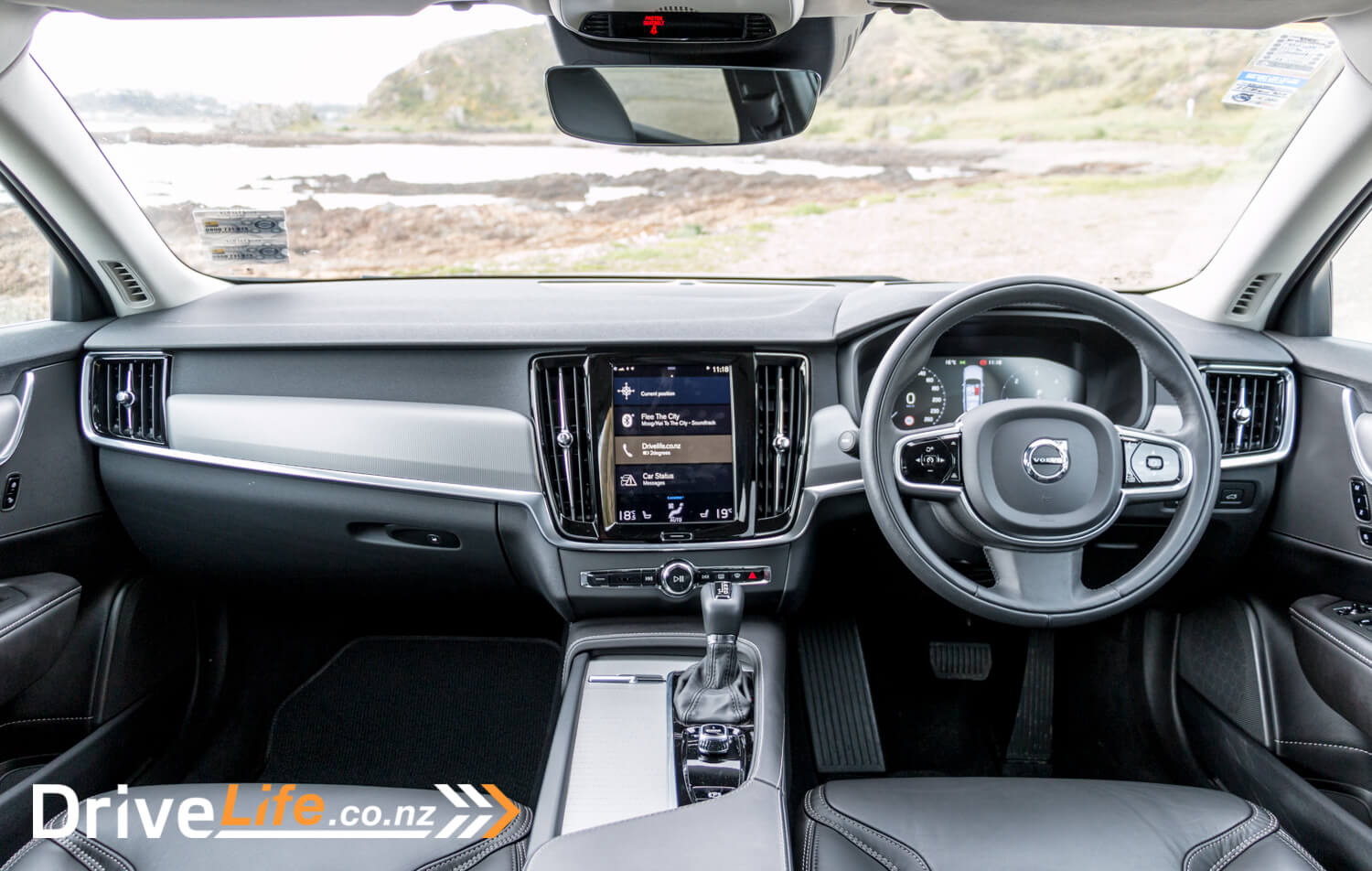
The Inside
It’s a similar story inside. The dark grey leather seats look excellent with their contrasting stitching, and are very comfortable to sit on. They’re electrically adjustable, with memory for the driver’s side. The dash itself is simply designed with straight lines and subtle metallic highlights, and a very minimalist layout with very few buttons. Almost everything is done via the central 9” vertically-mounted touch screen. The only buttons on the central dash are stereo controls, demisters and hazard light switch.
The main instrument cluster is fully digital with a digital representation of the classic twin-dial layout – speedo and rev counter. In the centre it displays a large graphic for whatever function you set it to – map, digital speedo, audio track readout etc. It’s very clear and crisp in all light conditions, and not over-busy like some can be. I like the way it shows the current road speed at the bottom and when the speed changes it shows the upcoming speed behind the current so you can see what’s coming. It does this by reading speed limit signs, and it works very well.
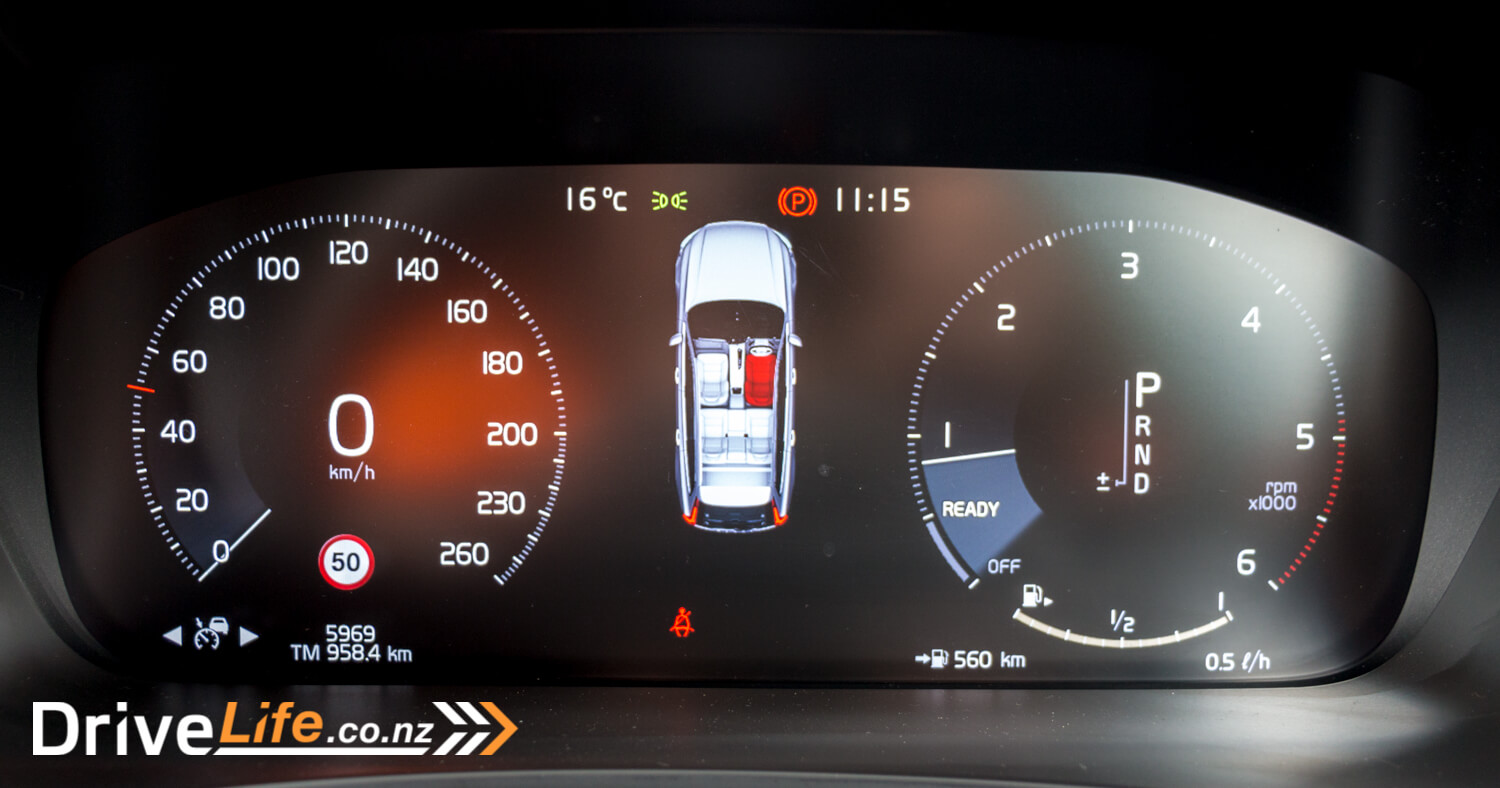
Added to this is a full colour heads-up display projected onto the windscreen. This can be configured to show various things but the main functions show speed and the current road speed limit. It can also show satnav directions and other information.
The steering wheel is leather trimmed and is comfortable and well-shaped. There are thumb buttons to control the cruise and stereo as well as operating the on-screen menus.
Back to that main display. When I realised that it was the only way to control most of the car’s functions I was a little concerned. These systems can sometimes be clunky to use, making it hard to find things quickly. I needn’t have worried, Volvo’s user interface designers have put some serious thought into this system and it is very well done. The main screen has large buttons for commonly used functions. Swipe left and you’ll find icons for all of the car’s apps, such as Spotify, Yelp etc. Swipe right and you get the settings screen, plus other functions such as auto parking.
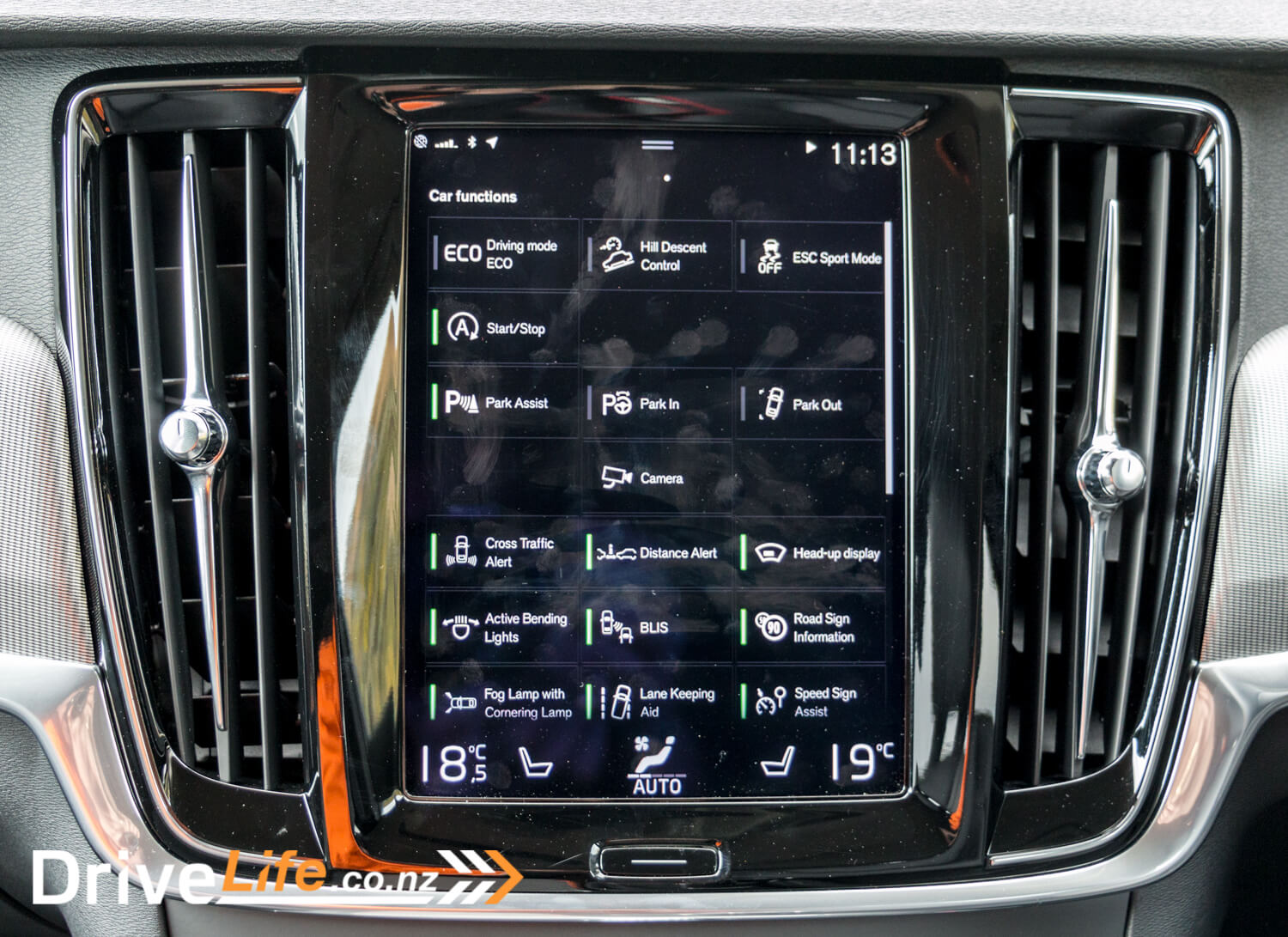
The icons can be moved around so you can group and position them as you like. For each function you can swipe down from the top and get its settings. It’s all very intuitive and easy to use. As you can see from the photos the display does show fingerprints. This is less obvious when you’re actually using it. Don’t worry though, Volvo supplies a cleaning cloth and a button to enter cleaning mode so you don’t accidentally set anything off as you clean it.
One cool feature is that you can set up user profiles for the car – up to three per key – and they remember everything for that driver. Seat and steering wheel position, climate settings, stereo settings, radio stations, everything. These can even be backed up to USB and loaded into another Volvo. Clever stuff and potentially very useful.
All of the parts you generally touch are trimmed in slightly padded leather, giving the interior a real feel of quality and solidity. Everything just feels nice.
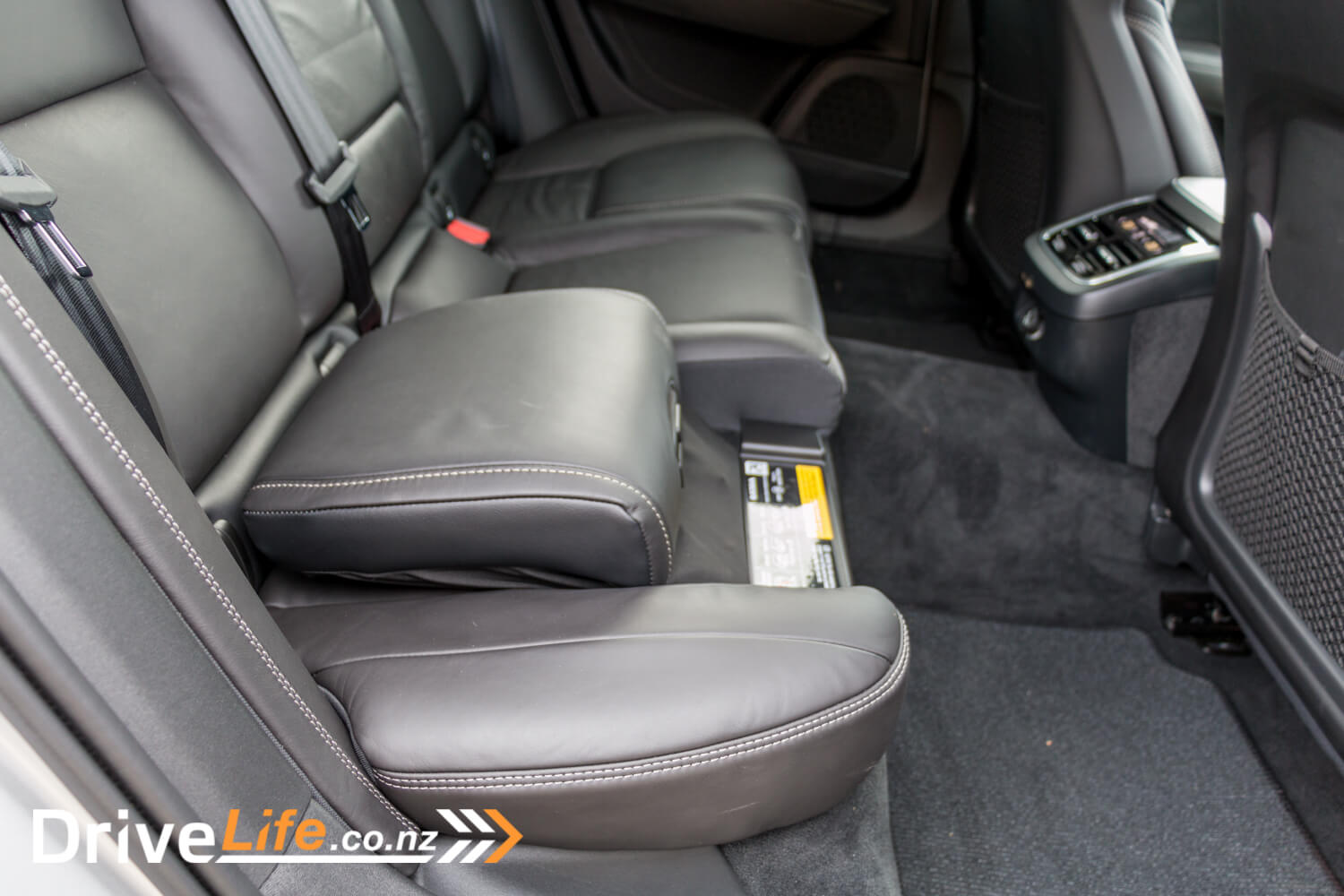
The rear seats are comfortable with huge amounts of legroom, it’s massive in there. So big you might struggle to reach the controls for the rear dual-zone climate control. I have a seven year-old, so one of my favourite features of the V90 is that the rear seats have built-in child booster seats. Just pull a lever and a booster folds up and into place. Very clever!
Moving around to the back, there’s a massive boot – 560 litres, expanding to a cavernous 1526 litres when the 60/40 split rear seats are folded flat. There are tie-downs and hooks, as well as a power socket in the boot side. Opening the power boot also pulls up the load cover to allow easier access. The boot can be opened by pressing the button on the tailgate, with the remote or by waving your foot underneath the bumper if your hands are full. The boot floor has a storage compartment underneath – lifted for you by a gas strut – which is secure even if someone was to smash a window to get in.
John took the Volvo for the last few days of the review, on a trip from Wellington to New Plymouth. Its a 4 and a half hour trip there, and the same back. And he said that it’s an amazing car for long distance traveling. You get our so refreshed, without any aches or pains. A true testament to the comfort levels delivered by Volvo.
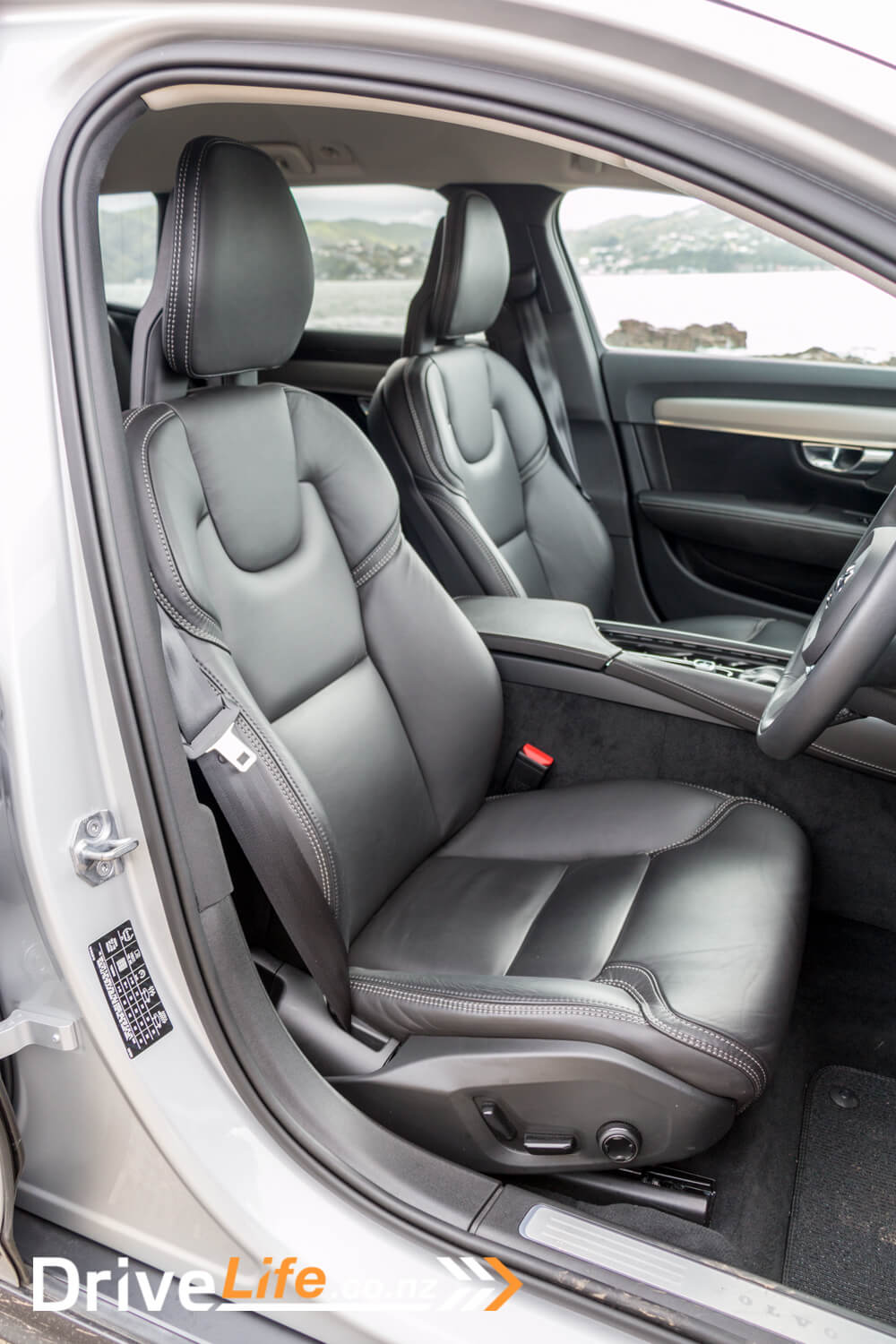
The Drive
Starting the V90 is a little different to most cars – instead of a button there’s a knob behind the gear shifter which you turn clockwise to start, anticlockwise to stop. Next to this is the button for the electronic handbrake, but you never really need to touch that as it engages and disengages automatically.
The V90 is a big car at almost five metres long and 1.9 metres wide, but it really doesn’t feel it. It feels solid, and reassuringly well built, but not overly large. With that twin-turbo diesel engine it has plenty of torque to get you moving along. It sometimes has a fraction of a second of lag when setting off, but that’s instantly forgotten as it lunges forward enthusiastically.
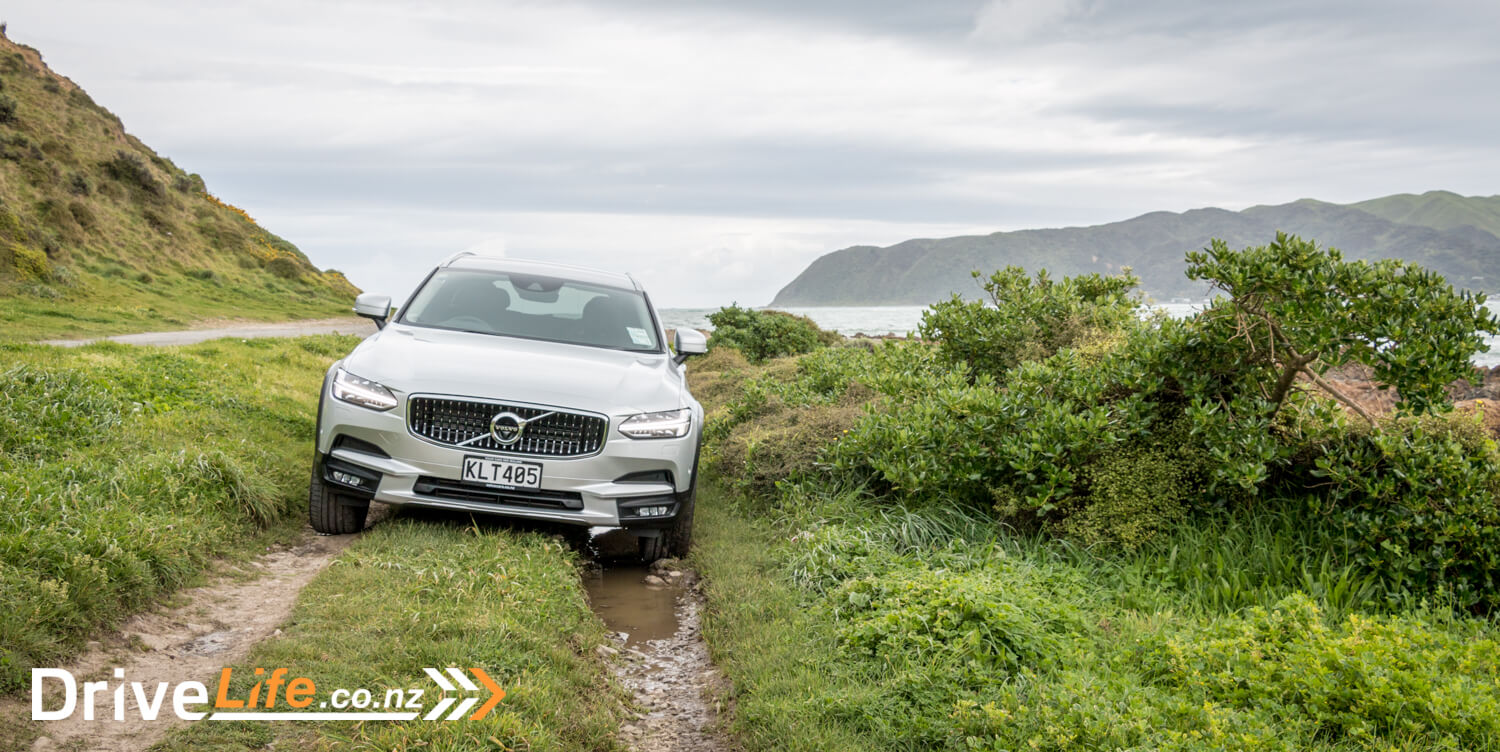
As usual one of my first journeys was in traffic, giving me the chance to try out the cruise control. The V90 has radar cruise which can come to a complete stop, and this is combines with steering assist, with the car reading the road lines and providing a little steering input on corners. I found the steering assist a little intrusive as it started to steer just before I did, so I eventually turned it off. John found it similar on his trip to New Plymouth, however he mentioned that on longer trips, this system really stepped up into a league of its own. After the first 40-50km, you start to get used to how it works, and it works very well 90% of the time. The other 10% was due to hard to see lines, or no lines on both sides of the road. The system itself gives you the feeling that someone is just behind you, lightly guiding the wheel as you drive along. And for long trips, it really carries some of the weight of the constant concentration that’s generally on the driver all the time.
The V90 has lots of semi-autonomous drive features to keep you safe, such as Blind Spot Information System with Steer Assist, which not only gives you a visual warning of a car in your blind spot but can steer you back into your lane to avoid a collision. Then there’s Rear Collision Warning and Mitigation, which will flash the hazards if a car approaches you fast, and apply the brakes (if stationary) and seatbelt pre-tensioners if it thinks you will be hit. There’s Autonomous Emergency Braking with cyclist and large animal detection at night, which can stop you hitting things, and in the latest 2018 update also allows the car to steer itself to avoid a collision. These are just a few examples of Volvo’s safety tech. You’d have to try pretty hard to crash one of these cars, and even if you did, it would do its best to minimise your injuries.
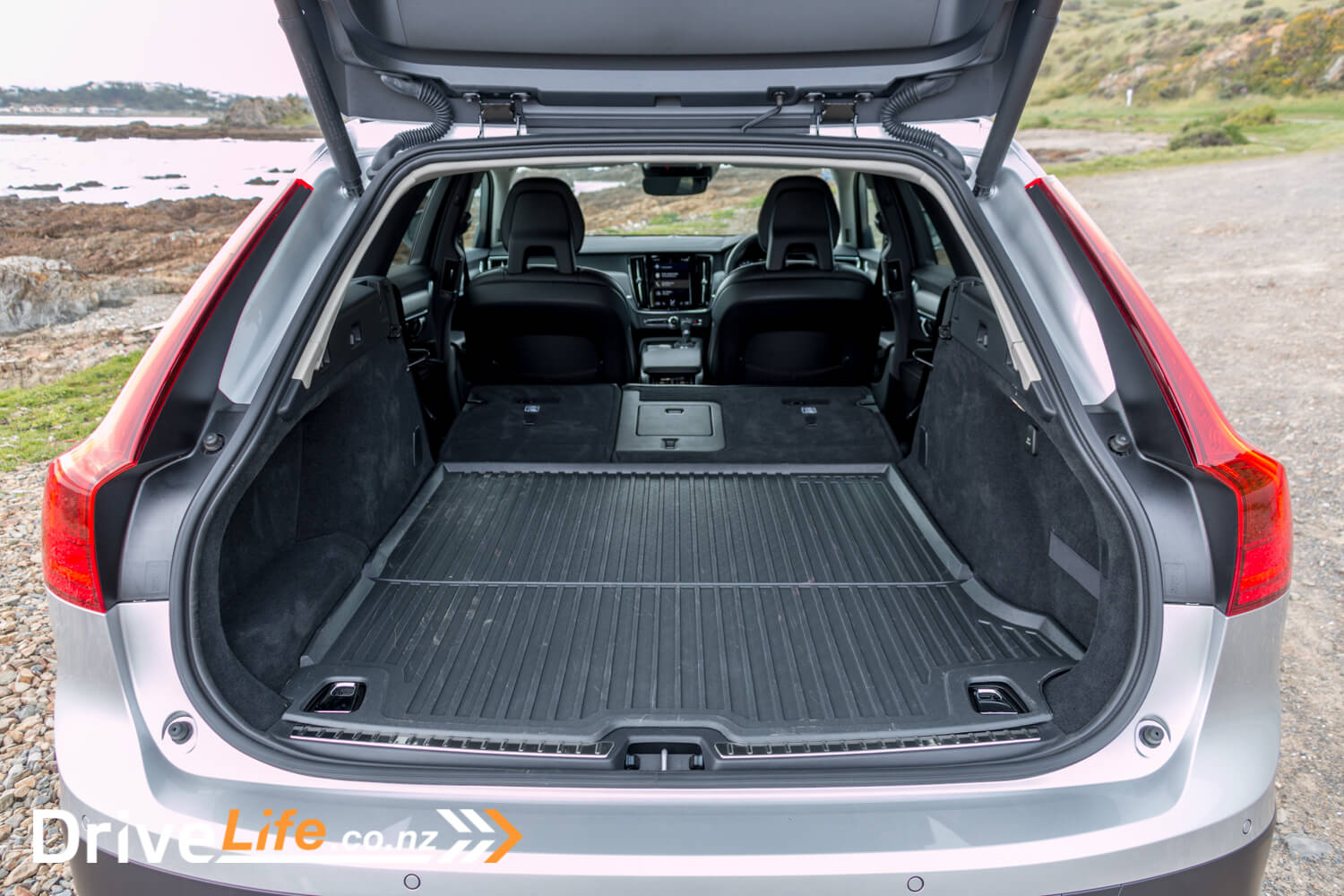
John said that he experienced this early warning safety systems on multiple occasions. Which demonstrated how well it was able to predict what is going on in it surroundings. With a flashing image on the heads-up and loud bing on the dash, you can feel the whole car getting ready in the event one of its many prediction results in an accident. But each time, it evaluated the surroundings, and was able to disengage without any interference. Some might see this as annoying, but John felt that the comforting sense that there is someone else keeping an eye on things, giving you the driver another chance in case the worst was to happen.
The Bluetooth pairing process went flawlessly, and I was able to test out the Harman Kardon stereo. The sound is very good, with ten speakers as standard, giving plenty of bass and decent clarity. This system can be upgraded to a 19 speaker Bowers and Wilkins system, or you can spec a rear sub if you like to boost the bass, but for most people the standard system will be more than good enough.
On a longer trip, the V90 performed beautifully. Road and wind noise are well-damped despite the large side mirrors. Talking of those mirrors, I found them to be fantastic for seeing behind me, but combined with the fat A-pillars they often made seeing at roundabouts difficult. If you’re taller than I am then it might not be a problem but for me they were frequently in the way.
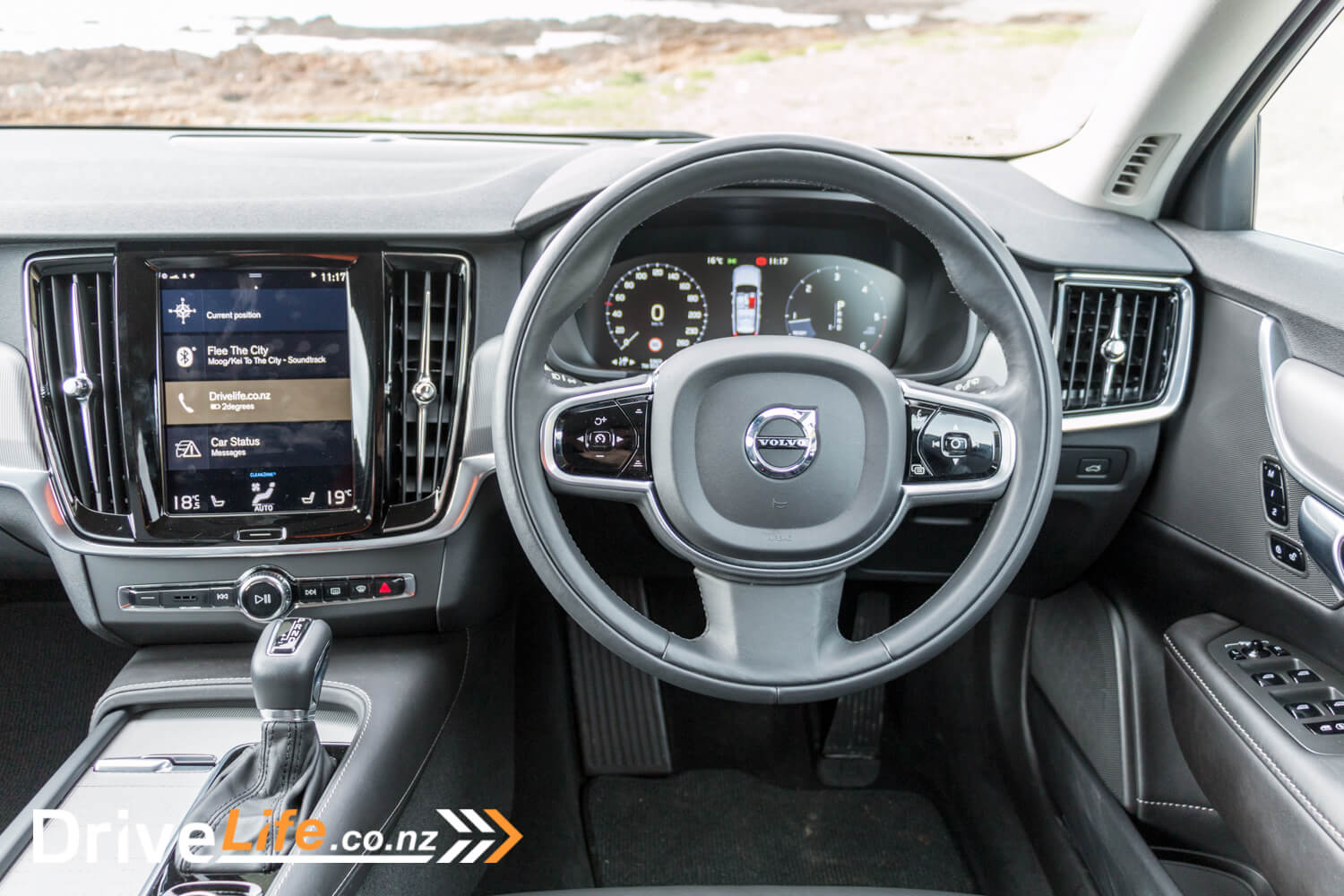
I was not able to take it on a long trip, but on John’s trip to New Plymouth, he had a good 9 hours of driving to put the Volvo through its paces. He reported that the ride quality was excellent, the combination of the interior seat comfort and the higher ride height of the all-road vehicle on NZ roads resulted in a perfect combination. He also reported that the engine was one of the better diesel engines he had ever driven. It’s so quiet, even under load, thanks to the twin turbos. But if he had to guess without knowing what it was, he would have said a 3.0L petrol, not a 2.0L turbo diesel. The power available when driving was also impressive, if you need to overtake, without much strain the car surges forward, remaining quiet and refined. Hats off to Volvo once again.
At night, the adaptive LED headlights work beautifully – swivelling the beam on corners and automatically bending the high beam around oncoming traffic. Clever stuff and it makes night driving much less stressful. Added to this are auto-dimming side mirrors as well as the interior mirror. Not a common feature even on high-end cars.
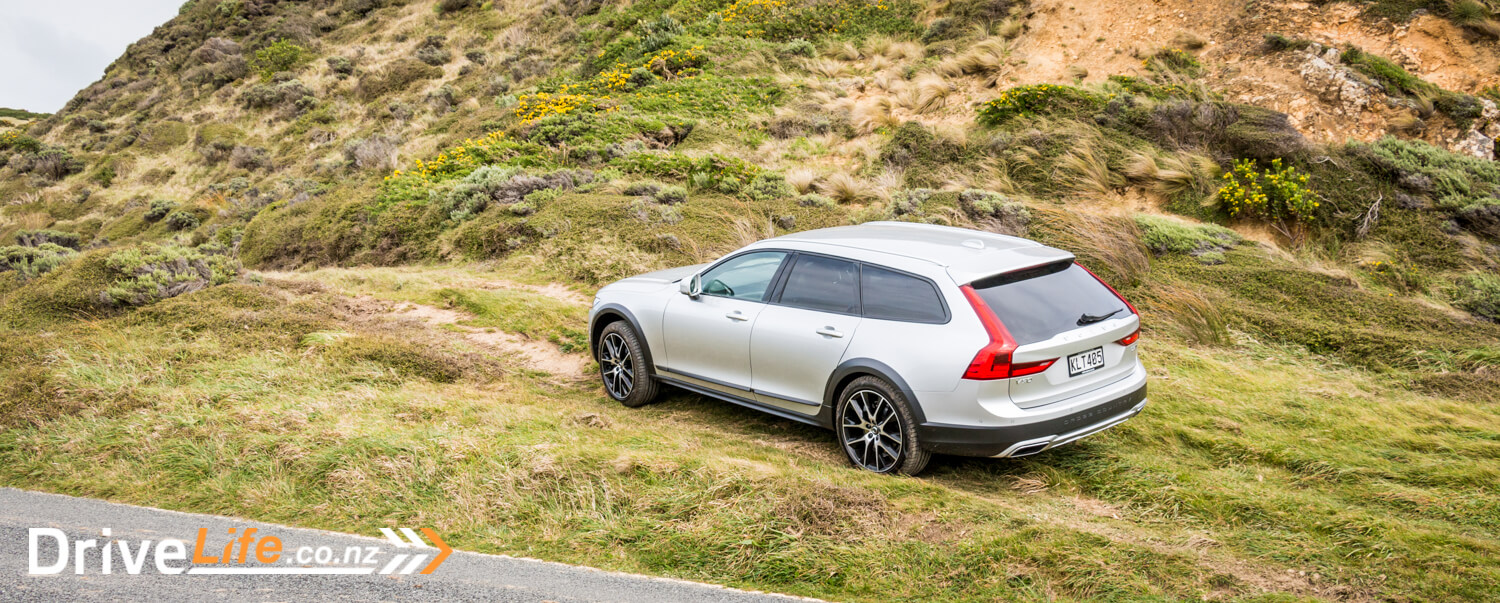
What about off-road? Volvo bill this car as an all-roader with the ability to cope with any conditions, even some light off-roading. It has 210mm ground clearance and a wading depth of 300mm, so it’ll get through the average stream pretty comfortably. I took it down a couple of muddy, rutted tracks and didn’t tax its abilities at all, it just ate them up quite happily. I have no doubt that this car can get you along any road you throw it at.
The V90 has a few other cool features. I like the way the washers are built into the wiper arms. It’s a neat solution, even though it seems kinda weird the first time you wash the windows. Then there’s the clean air system that blasts air from the front to the rear of the car after you get out, to freshen the interior air.
I like the illuminated, but not overdone, sill covers. And there’s the auto parking. I tested out the parallel park function – it works very smoothly, telling you clearly what to do on the displays, and parking the car without fuss. Like most of these systems it controls the steering and tells you when to select forward or reverse, start and stop. I tried to get it to pull me back out of the space I picked, but it told me I had plenty of space and I could do it myself, which was true!
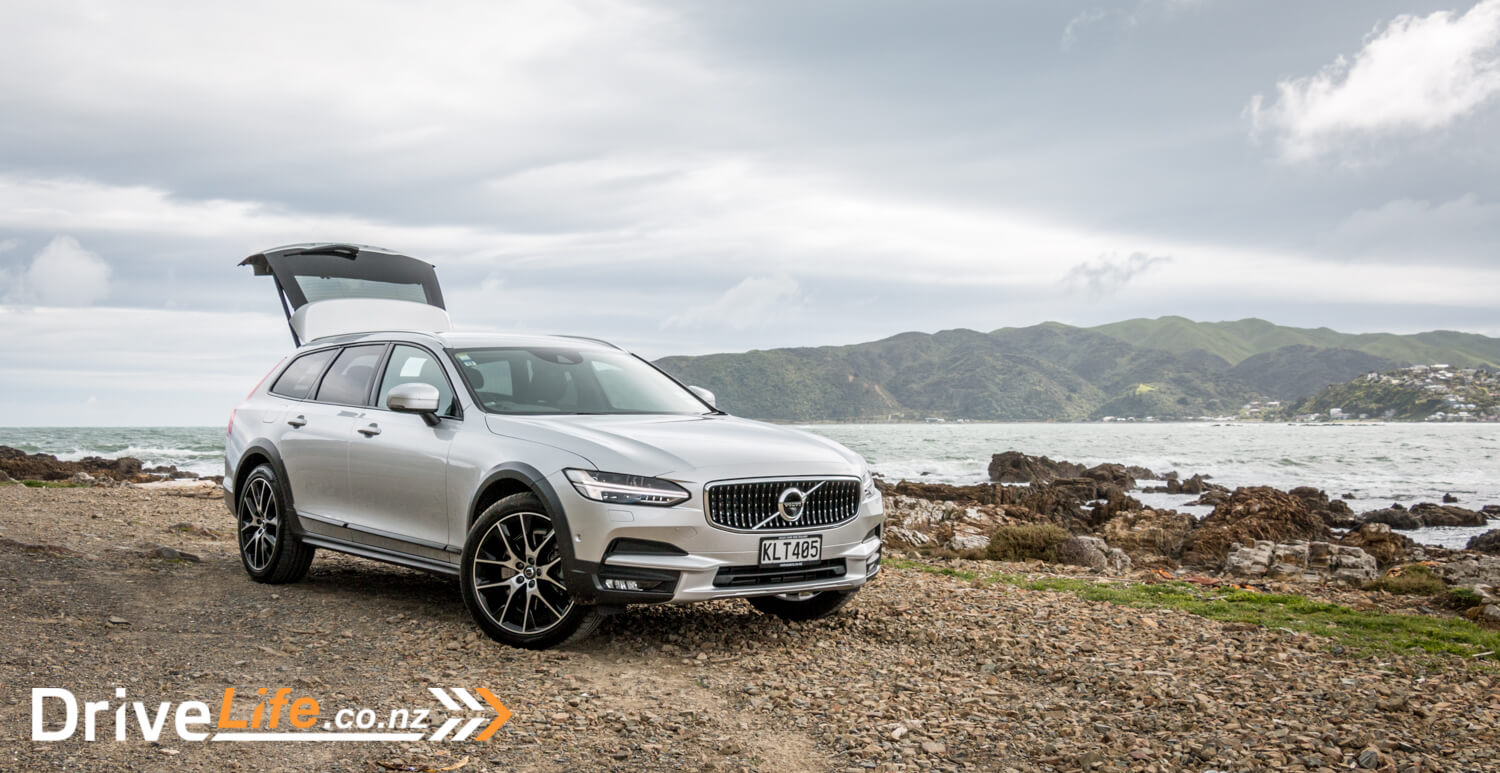
The Competition
Diesel wagons are not that common, especially in this price range. The Volvo is looking like very good value here.
| Brand / Model | Engine | Power | Fuel L/100km | 0-100km/h | Price Highest to Lowest |
| Jaguar XJ Premium Luxury Sedan | 3.0l 6 cylinder twin turbo diesel | 221kW/700Nm | 5.7 | 6.2s | $155,000 |
| Audi A6 BiTDI S Line Wagon | 3.0l 6 cylinder twin turbo diesel | 235kW/650Nm | 6.0 | 5.2s | $151,900 |
| Mercedes Benz E350d Sedan | 3.3.0l 6 cylinder turbo diesel | 190kW/620Nm | 5.6 | 5.9s | $147,900 |
| BMW 530d xDrive Touring | 3.0l 6 cylinder turbo diesel | 195kW/620Nm | 5.5 | 5.6s | $139,900 |
| Volvo V90 Cross Country | 2.0l 4 cylinder twin turbo diesel | 173kW/480Nm | 5.3 | 7.5s | $103,900 |
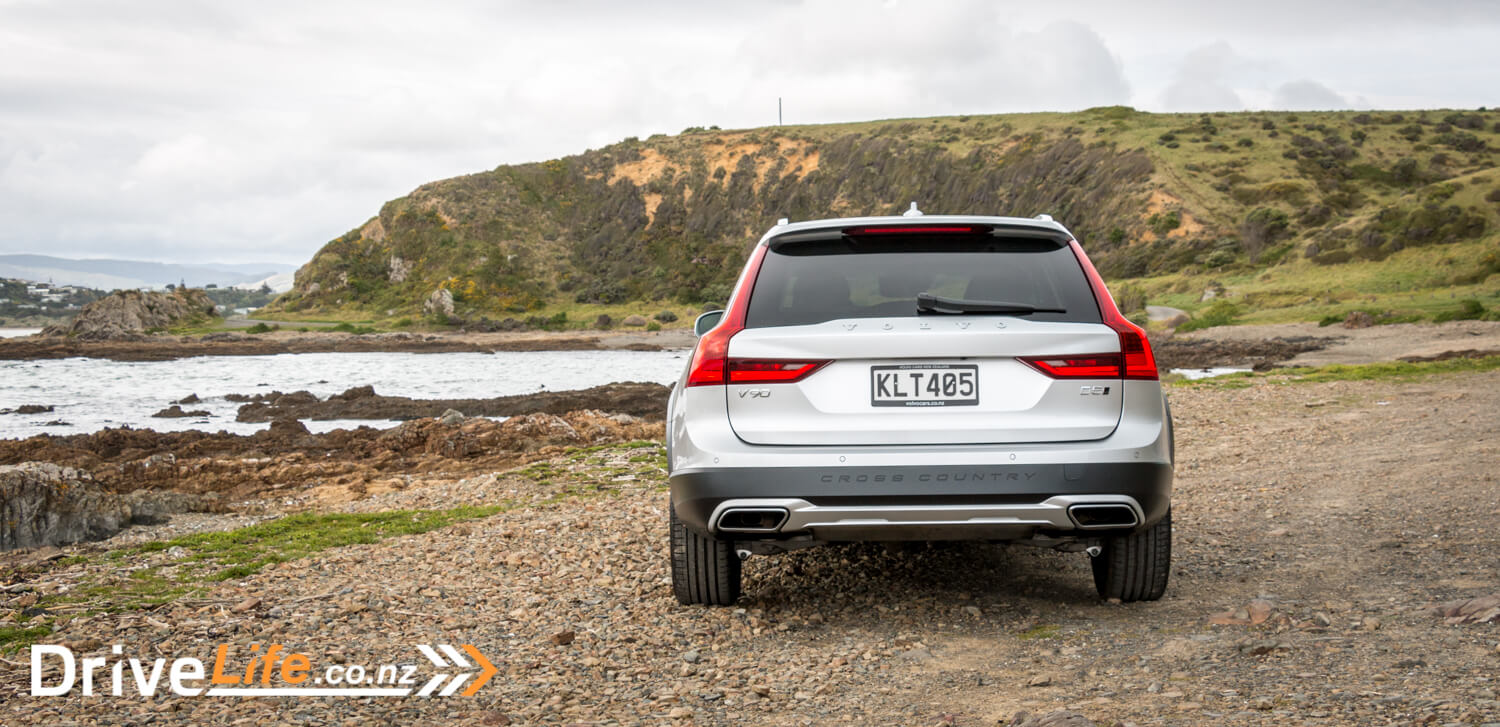
The pros and cons
| Pros | Cons |
|
|
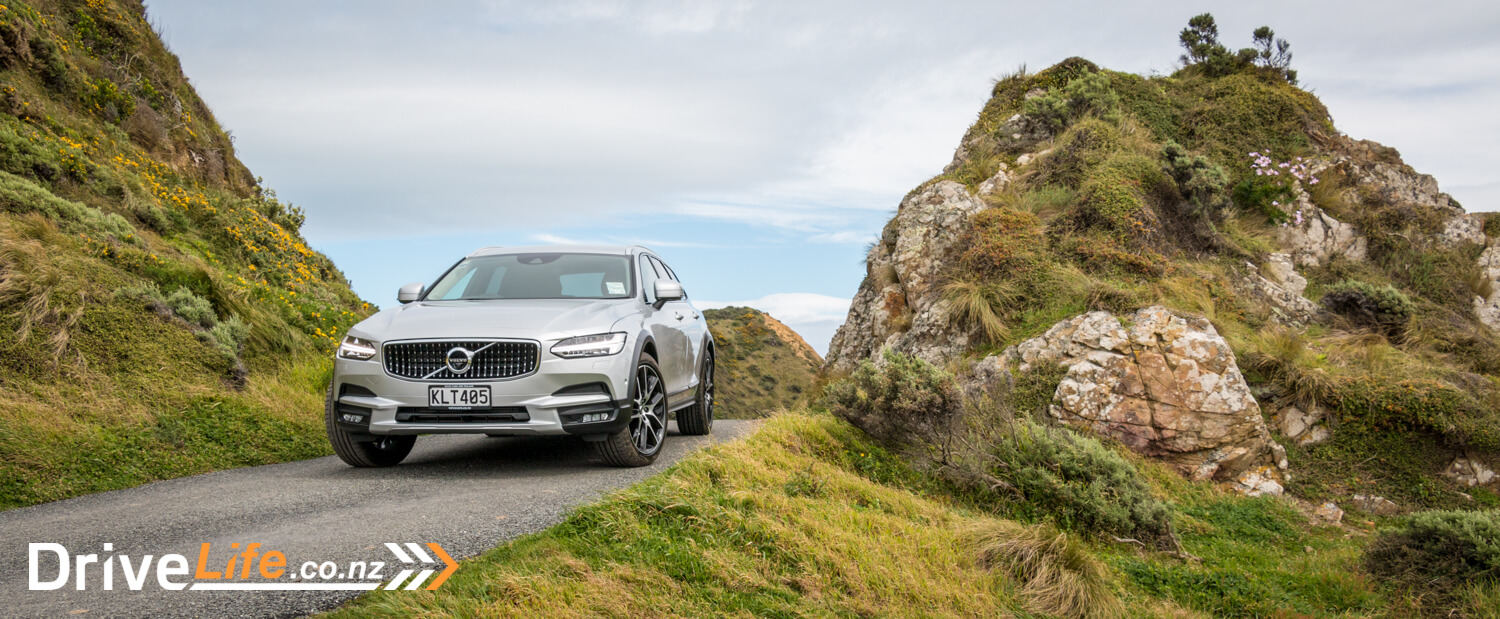
What we think
The V90 is an excellent all-rounder. It’s comfortable and quiet, has loads of space for people and cargo, and of course has lots of safety and technology. It looks the part too – imposing but not too in-your-face, understated, but flashy enough. It just seems to tick all of the right boxes for me. It’s the car for all seasons too, with good ground clearance and even some off-road ability.
And as for pricing – yes at just over $100k it’s not a cheap car but when you compare it to offerings from BMW, Mercedes and Audi, suddenly it looks like an absolute bargain. Well done, Volvo.
John also said this is another award winning car from Volvo, and that it can’t be argued that Volvo are bringing the cool back to wagons, even diesel wagons.

Rating – Chevron rating 5 out of 5
| Vehicle Type | Large All-Road Station Wagon |
| Starting Price | $103,900 plus on-road costs |
| Tested Price | $106,235 plus on-road costs Alarm + Interior motion sensor for Alarm + Private locking + Locking glove box $950 Tinted windows, rear side doors and cargo area $935 Heated steering wheel $450 |
| Engine | 2.0-litre, inline 4-cylinder, common-rail, twin-turbo diesel |
| Transmission | Eight speed Geartronic |
| 0 – 100 kph | 7.5 seconds |
| Kerb Weight | 1993kg |
| Length x Width x Height | 4936 x 1879 x 1543mm |
| Cargo Capacity | 560 Litres seats up
1526 Litres seats folded |
| Fuel Tank | 60 litres |
| Fuel Efficiency | Advertised Spec – Combined – 5.3L / 100km
Real World Test – Combined – 7.0L / 100km |
| ANCAP Safety Ratings | 5 stars |
| Warranty | 3 year warranty
3 year AA Roadside Assist |
